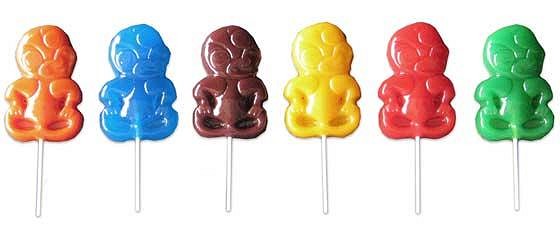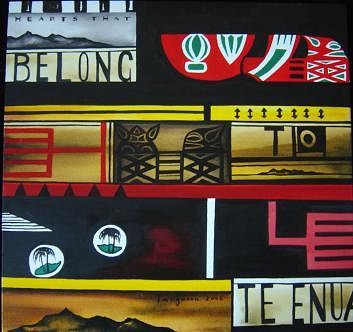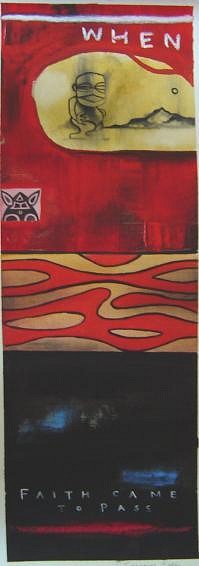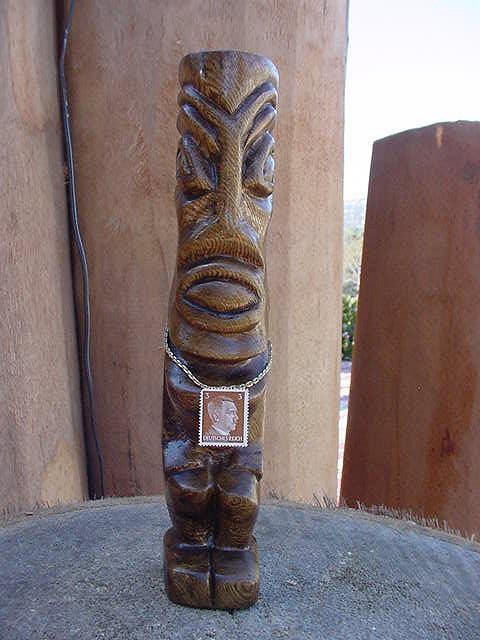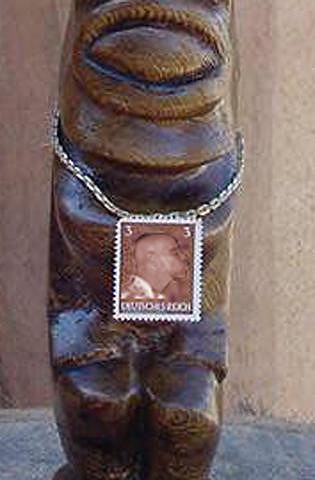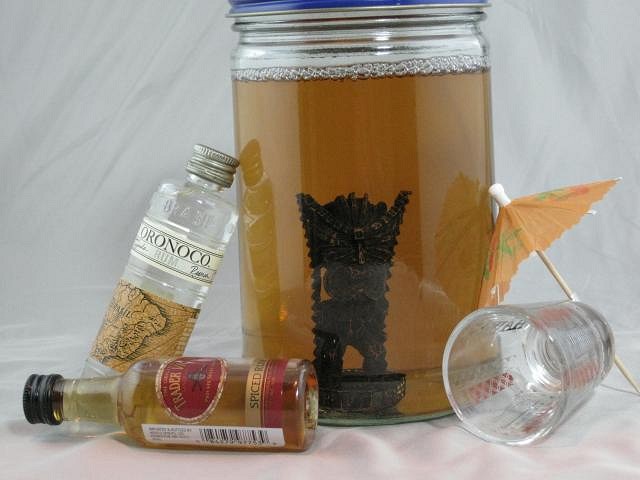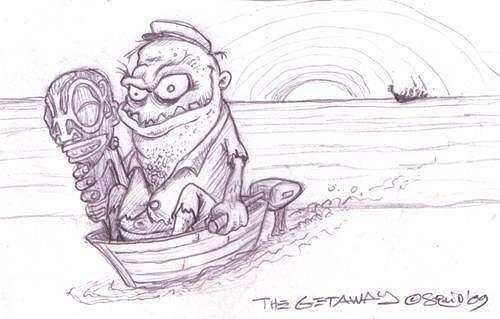Tiki Central / Other Crafts
Discussion on the "objectives" of tiki art�
|
H
hewey
Posted
posted
on
Thu, Dec 28, 2006 9:36 PM
One thing Ive been mulling over for a while, particularly since the �shot in the arm thread�, is the issue/topic of whether tiki art/tiki artists have an objective. Without a doubt, creating good looking work is paramount to pretty much all tiki art. But when comparing tiki art to more mainstream/highbrow art, one of the biggest differences I see is a lack of political and social observations/criticisms. I would suggest that very few tiki artists create work that challenges the audience to think beyond �oooh, that�s pretty�. Which is fair enough. For most of us tiki art is about great times and good old-fashioned escapism and romanticism. From a sociological/psychological perspective, many of us were self-confessed nerds at school. And its well known that many nerds escape into fantasy worlds via books, movies, cubby houses etc. Given the global political/war issues, and everyday issues like bills, work etc, its not surprising we like to kick back with our feet up, Mai Tai in hand, and escape the everyday. Hey, that�s how Poly Pop started isn�t it? And its great to do this sitting in your bar area, admiring the bright and fanciful colours of your Shag print. But sometimes I find myself wanting more. Wanting a bit more substance, a bit more bite? A proverbial shot in the arm. Take Shag for example. His art looks great, without a doubt. But not many of his pieces REALLY draw me into his paintings. There�s a few that encourage you to develop your own backstory, like the pieces along the lines of the magic 8 ball � �signs point to yes�, and the piece �Heavy religious conversation�. But by and large, it�s a case of �That�s pretty. Next� for me. I find the art of Thor a lot more engaging. Again, stunning, STUNNING art. Positively drool worthy in my books. As he has commented before, a lack of people in his paintings encourages people to imagine themselves in the painting (theres that escapism thing again). And pieces like his drink making machine series, they make you grin and look at them for ages imaging the machine in full operation. I also love stuff like spending ages looking at art from artists like Little Lost Tikis, with soooo many hidden tikis, or the details and use of light in tiki shark art�s work. Art that is pretty and engages you with the subject/scene. But I struggle to find tiki art that goes beyond this level of engagement. Art that grabs you by the balls, stares you down, and asks �What the hell are you looking at?!� Within poly pop there are issues that people get fired up about � take the whole traditional vs. poly pop style clash, demolition of old tiki bars etc etc. Why don�t we see tiki art making social commentaries on these issues? How about a depressed tiki sitting outside an old A-frame bar with an eviction/demolition notice on the door? Or even tiki themed art that makes criticism of global politics or something? Within wider �lowbrow� art, there is more emphasis on �darker� more political and social themed work. But even there, there�s the whole so-called �unibrow� phenomenon of �same-old same-old� art with no punch. So, basically I want to discuss �the point� of tiki art. Yes, I totally agree that primarily aesthetic art is, and always will be the main focus of the majority of tiki artists. But does tiki art need a shot in the arm, a bit more punch? Kustom Kahoona* - Tiki and Hot Rod Art by Hewey* [ Edited by: hewey 2006-12-30 19:39 ] |
|
T
teaKEY
Posted
posted
on
Fri, Dec 29, 2006 8:01 AM
Hey Hewey, I'll bite I don't think that their is enough art talk here and at the same time, much art is being produced. I would totally not agree with this. I see new ideas born everyday here. Like in all fields, if I see only one new thing in the area that interest me each time I look, I'm happy. "Take Shag for example. His art looks great, without a doubt. But not many of his pieces REALLY draw me into his paintings., But by and large, it’s a case of “That’s pretty. Next” for me." I thought that Shag was great the first time that I saw him. It was fresh from the other stuff and then the next time that I saw him, I thought yep, I see the styling he uses and then the next time, yep nothings changed. Recently Shag did tried something new with in his style with the detail painting and he probably is the only one to have social issues in his painting with his latest painting. The painting with the televisions that are live to national disasters. I enjoyed seeing Tiki Tony work his paintings into 3-D art. The mugs and the bird heads which is what I would have bought for Tiki Art Now. And yes, Dr. Seuss did the same thing with mounted head, But I didn't think to do it again until I saw Tony do it. Crazy Al pulled out all the stops to make that PNG skull painting with the best tiki frame ever. That was a big surprise. I think Benzart did his best recently with probably one of the best Moai to ever see the light to date for me, and I'm a Moai freak. Really, how many ways can a Moai be done, there are limits to work under. Munktiki hit the nail on the head with the Kustomas mugs that are very new ideas for them, more work and creativity to pull from a given shape. I think that this year has given me more to think about with tiki. Maybe tikis best year. We had to go through all the history of tiki to get to this moment. Do I want a depressed tiki hanging on my wall?? I first thought no, but hell yeah. Its a human side of life. Can tiki change the world, sure it can, but its changes are little and made within a small group that is growing. Are all the artist here on TC giving the shot in the arm, no. But everything takes time. You got to get to the base on the mountain before you can start to climb. |
|
CS
Capt'n Skully
Posted
posted
on
Fri, Dec 29, 2006 1:03 PM
There are some artists here that go rather unnoticed as such, and they are the collectors themselves. I know several people with incredible collections that will give you that "what the hell am I looking at" feeling.. From this perspective, each piece of art (or mug) becomes a part of a larger composition- the entire tiki environment/collective they've put together becomes the work of art itself- And each individual piece holds a unique story/history adding an initially unseen color. I think the demolition of old tiki bars would make an excellent topic for a piece or series.. An also think it already exist in private collections. Maybe not said as well as it could have been, but that's 2 cents to throw in the volcano.. :) |
|
S
saxotica
Posted
posted
on
Fri, Dec 29, 2006 2:50 PM
I don't think Art is valued very highly here on Tiki Central. I think what is valued here is Craftsmanship. It seems [to me] that folks would rather see a perfectly executed copy of something they've seen before [ie. a Ku] than anything different. |
|
H
hewey
Posted
posted
on
Fri, Dec 29, 2006 3:55 PM
Upfront one thing I didnt say that I should have acknowledged is none of the art I have produced attempts to deal with issues of this nature.
Totally agree.
Okay, that came out wrong on my part. I agree that there is always new stuff that makes you think about quality of workmanship/technique etc. I meant beyond this stuff to more social questions like "why is the tiki depressed the bar is being torn down? What little things can I do to preserve poly pop culture, given that so much is being destroyed." I wasn't clear in saying that though.
An interesting point captn, I hadn't considered the net effect of a poly pop collection as being art. And said clear enough :)
I agree that craftmanship is valued most highly, but I still think people get a kick out of new interpretations of traditional items. I got a PM from someone also saying they don't believe art is highly valued on TC. Their comment was that poly pop incorporates the usage of what were originally religous icons, of polynesian cultures which have already been highly impacted upon (think missionaries, colonialisation, and now the impacts of 'western' society via globalisation). So people are wary of using these icons to make social statements in art as a result. |
|
V
VanTiki
Posted
posted
on
Fri, Dec 29, 2006 4:03 PM
And thus the doors to the great Art vs. Craft debate have been thrown wide open! :) Seriously, though - I feel that saxotica is onto something here. I am a great lover of the Arts and Crafts (aka Craftsman) movement in American design - as well as the Edo period in Japan. Both movements celebrated the beauty and craftsmanship of everyday objects. In a way - Tiki mugs do the same. They are functional art - a beautiful object that also serves a practical purpose. Does art have to do something more than simply be pleasing/interesting to the eye? Perhaps - maybe this it the litmus test for the difference between art and craft. One could argue that the Arts and Crafts movement had a deeper drive - shunning the mechanical drudgery in design spurned by the industrial revolution and attempting to bring humans in tough with the materials that surround them. Tiki mugs could be argued to have a deeper meaning as well - a talisman/reminder of a unique period of history, a touchstone to a forgotten place/mindset, an embodiment of a hidden and dark inner id, etc... whew - I gotta get in the studio and start pushing some clay! VanTiki [ Edited by: VanTiki 2006-12-29 16:06 ] |
|
T
teaKEY
Posted
posted
on
Fri, Dec 29, 2006 4:21 PM
I think that Saxo is right. Art is one thing, craftmanship is different and craft is far another. "Arts and crafts" is not art to me. I call "arts and craft" arts and crap. Craftmanship can is part of art and usaully is but art is usually not craftmanship. But this posting started out as a tiki art objectives and I certainly have mine. My Objectives: . |
|
V
VanTiki
Posted
posted
on
Fri, Dec 29, 2006 4:54 PM
Whoo! Way to keep an open mind! :wink: |
|
P
Paipo
Posted
posted
on
Fri, Dec 29, 2006 5:00 PM
I'll throw in some other viewpoints here seeing this is a pretty interesting topic. The simple answer is, it's called "lowbrow" for a reason - Tiki is an art style that essentially serves as window dressing for (and a celebration of) an escapist culture and lifestyle. We also have the slightly less frivolous aspect of study and reproduction of artifacts. Amongst the best practitioners I see it as a homage to the unknown craftsmen of Polynesia who left such an amazing legacy of work in the world's museums. A good example being this thread here, where things come full circle and an artist is able to pass the knowledge back to someone who has been disconnected from the source. For Tiki to tackle issues and raise questions would defeat the purpose of it all. If I want art that provokes questions I'll go to a big city gallery (and I often do). If I want something that I think looks cool and makes me smile or dream of far-away places, I'll come here. I have much more fun carving tikis and dealing with passionate collectors than I do trying to climb the ladder of the contemporary jewellery / gallery scene here, where everyone wants some sort of deep meaning behind the motivation for your designs. It would be tragic to see the fun sucked out of the whole tiki genre and for it to become yet another ego and bullshit driven facet of the fine art world. I think ideas along the line of the sad tiki outside the demolished A-frame might work, but would risk veering into the realm of 9/11 and Dale Earnhardt tribute style kitsch that ultimately becomes self-parodying. All that said, there is plenty of art around in New Zealand using tikis from Maori and Polynesian culture to make political or cultural statements, by both indigenous and European artists. But is it "Tiki" as we know it? Some of the art from the US shows I've seen would probably be trashed by political activists if it was shown here (Marcia Brady with a moko springs to mind). Cultural appropriation is a very thorny issue in NZ. Here's one:
We bought these two in Rarotonga:
There are literally dozens if not hundreds more examples to be found, as using Maori and Polynesian motifs is very much in vogue at the moment and has been for the last 10 years or so. |
|
P
pdrake
Posted
posted
on
Fri, Dec 29, 2006 7:20 PM
good grief. take a class already. it's called lowbrow for a reason. |
|
R
RevBambooBen
Posted
posted
on
Fri, Dec 29, 2006 8:03 PM
Cheers! |
|
S
saxotica
Posted
posted
on
Fri, Dec 29, 2006 8:29 PM
? |
|
G
Gigantalope
Posted
posted
on
Fri, Dec 29, 2006 8:51 PM
There was a fantastic thread a year or so back about a gallery opening in London (I think it was London) where people had rendered Polinesian Images with crap from modern culture like Mc Donalds Arches...I would consider that a splendid use of Tiki in a modern and sort of cutting edge context. (Though that sort of mixing of iconography is a bit trite) I am 'probly alone in this, but I feel in this age of over-sensitivity and law-suites, we've lost some of our ability to laugh at ourselves. People might make more risks in a less PC Climate with cultural and religious icons. Example: Link to Concept Car Dodge "Kahuna" Link to petition to stop the production It's interesting to consider what of modern "Tiki" (both Art and Craft)would be produced if it were not for it's commercial value. Who would "Produce" just to be doing it? It seems to me the one group that would still be there in large numbers would be the Musicians, perhapes more than artists of other mediums considered "Tiki". Thoughts? |
|
B
Bowana
Posted
posted
on
Fri, Dec 29, 2006 9:50 PM
I don't think Tiki art is about making political or social statements. I believe it's more about enjoying one's self, and for the enjoyment of others who appreciate it. Collectors play a vital role. Someone who collects dog figurines for example, would not want, nor would expect any of their dogs to be any kind of controversial art piece. Their collection reflects a personal interest and enthusiasm for the subject matter. It's about conveying good feelings and having fun with it. That is my reason for doing it. |
|
R
RevBambooBen
Posted
posted
on
Fri, Dec 29, 2006 10:19 PM
I say, Knock knock. And, you say, who's there? |
|
BPB
Bay Park Buzzy
Posted
posted
on
Mon, Jan 1, 2007 12:24 PM
[ Edited by: Bay Park Buzzy 2007-01-01 12:29 ] |
|
JT
Jungle Trader
Posted
posted
on
Mon, Jan 1, 2007 1:28 PM
Right BPB. Now somebody will come on who is offended and then you will say that you are Jewish. Get lost. |
|
R
RevBambooBen
Posted
posted
on
Mon, Jan 1, 2007 10:13 PM
Art is in the eye of the beholder? |
|
JT
Jungle Trader
Posted
posted
on
Tue, Jan 2, 2007 6:01 PM
Tell me where the swastika is. All I see is Hitler, murderer of millions of Jews. Why would anyone glorify him? To provoke anger? |
|
LLT
little lost tiki
Posted
posted
on
Tue, Jan 2, 2007 7:06 PM
I don't see Hitler-I see GROG! He's worse! |
|
R
RevBambooBen
Posted
posted
on
Tue, Jan 2, 2007 8:57 PM
JT, I think BPB was showing some "artistic anarchy" like that dude who did the piss christ a while back. |
|
R
RevBambooBen
Posted
posted
on
Tue, Jan 2, 2007 9:06 PM
p.s. I guess "Subject Matter" comes to play somehow? |
|
BPB
Bay Park Buzzy
Posted
posted
on
Fri, Jan 5, 2007 10:03 AM
|
|
SF

Slacks Ferret
Posted
posted
on
Thu, Jan 11, 2007 7:46 PM
Like JT said, you put a pic of Hitler, not the swastika. That's what would most likely piss off some folks. The whole swastika as a good luck symbol is an interesting point. However, there's nothing like a holocaust to change/update folks perception on an ancient symbol. But tell me Bay Park Buzzy...are you trying to save the humble swastika from it's sHitler associations like Manwoman? http://www.manwoman.net/swastika/ Or you just f%*kin' with us?
[ Edited by: Slacks Ferret 2007-01-11 19:56 ] |
|
T
Tamapoutini
Posted
posted
on
Sat, Jan 27, 2007 11:24 PM
Wickid! Now here's something to distract us from our tiki making (deep/meaningful/challenging or otherwise) Many good points made, too many to go quoting them all, so here goes my rambling subjective 2c on the 'objectives' of tiki-art & art/craft in general... Art is Art. As a fulltime artist/craftsperson I can fully appreciate that not all work is created with a view to change the world. We all have to eat & it doesnt take long to figure out that 'pretty things' generally sell better than Earth-shattering/thought-provoking things. This leads me to conclude that there are more people in the world who like pretty things than there are art-appreciators wishing to be challenged. I personally would love to be producing work that would grab your balls Hewey, but suspect that a living would be very hard to achieve in doing so. :lol: I think that those rare artists & pieces that confront (*even the lowly craftsman sometimes indulges in creating something less pretty & more ball-grabbing) are the precious gems of the art realm. It is perhaps their rarity that lends the punch; if we were all producing deep n meaningful all of the time, it probably wouldnt seem so deep n meaningful..? There is also the problem of offence. Stray too far away from Pretty & you're bound to piss someone off. Not the end of the world you might say; try it I say! I have had a few disgruntled windowshoppers for relatively minor offences I thought: it can be very difficult to weather an attack from a complete stranger over something close to your heart & much easier (& less frequant) to let slide similar comments on less Serious work. Another reason for its' rarity..? Jump: I agree fully with Capt'n Scullys comment on a collection (of supposedly 'lowbrow' art) often making a statement in itself & in practice this relates to a point Paipo makes - One tiki lollipop might just be a tacky souvenir: stick six of them on a board & all of a sudden you have a commentary on the misappropriation of cultural identity. Where/when does an object or image become Art? Is it simply the artists intent? What would happen if you put 1000 of those lollipops on a mountain top? or set fire to them? etc... My take on the great art/craft debate is that ART is in the eye of the beholder AND/OR in the intent of the maker. -Is a 'bad' painter still an artist..? What about a 'good'/technically proficiant painter who only paints bowls of fruit (even if photo-realistic); is his/her work art or craft? Does it have to be provocative to be considered art? What if the artists intention is simply to produce a laugh? Is amusing art, real art? Also, surely a 'good' painter is a Master of his 'craft'..? Just a thought. It does get a bit confusing which is probably why it has been such a long standing debate. If someone can see the art behind a tiki mug; great! If someone else thinks it is just a dumb old mug; well thats just as valid -to them! I believe there is meaning behind almost anything if you put your mind to it. Maybe the real litmus test for an artist is in having the intention reach the viewer in the form in which it was intended? I think most people would agree that Great Art is a combination of both; well made & at least interesting, if not necessarily challenging. I agree any sort of commentary beyond a pretty depiction or recreation is of value. If you are saddened by a particular tiki-bar being demolished, go right ahead; make a statement to that effect. One way to give the arts a shot in the arm, is to give it a shot in the arm... Jump: Hitler & the Swastika (swas-tiki?) What of it? It happened. And to use his image is a provocative thing for sure. But what of it? If it is too unnerving, dont use it. Or if someone else has used it in a work & you dont like it, then dont look at it and/or dont buy it, and/or buy it and stick it on a mountaintop/set fire to it - whatever. I agree with the Rev; 'artistic anarchy' is just as valid as anything else. There you go; a bit of a ramble. Wish I had some rum. Or some Tequila for that matter; now that stuff brings out the artist (and the controversy) in me! Take care. Make art. Make tikis. Original ones. Drink. Think. Dont think. Dont drink. Whatever. How about a tiki-poetry thread? A drunken tiki-poetry thread? (tiki poetry written whilst drunk or poems written about drunken tikis - or drunken tiki artists/craftspeople?) You guys are crazy! Or are you just drunk? :lol: TTT :) |
|
R
RevBambooBen
Posted
posted
on
Sun, Jan 28, 2007 7:58 PM
Right on Kiwi!!! |
|
K
kikekeki
Posted
posted
on
Sun, Jan 28, 2007 8:51 PM
I don't know, LLT... |
|
G
GROG
Posted
posted
on
Sun, Jan 28, 2007 11:43 PM
Tamapoutini, Everything you said is RIGHT ON THE MONEY. In fact, GROG pretty much consider that Basic Art Philosophy 101, and you explained it very well. Cheers to you (GROG raise mug). |
|
P
palapala
Posted
posted
on
Tue, Jun 23, 2009 8:23 PM
This is too much fun to just let lie. It inspired a "high art" photo shoot ( took about 5 minutes ) I expect to get thousands and thousands and thousands of dollars for it. :wink: BUMPITY, BUMPITY, BUMPITY, BUMP!
|
|
TM
tiki moon
Posted
posted
on
Wed, Jun 24, 2009 1:05 AM
A lot of this work is in the category of the decorative arts. The decorative arts are traditionally defined as ornamental and functional works in ceramic, wood, glass, metal, textile. The field includes ceramics, glassware, furniture, furnishings, interior design, and architecture. The decorative arts are often categorized in opposition to the "fine arts" http://en.wikipedia.org/wiki/Decorative_art It's not really meant to be much more than decorative. |
|
TM
tiki moon
Posted
posted
on
Wed, Jun 24, 2009 1:14 AM
http://en.wikipedia.org/wiki/Decorative_art [ Edited by: tiki moon 2009-06-24 01:17 ] |
|
P
palapala
Posted
posted
on
Wed, Jun 24, 2009 10:07 AM
I think that the line between decorative art and fine art has always been a blurry one, with no absolutes...If you throw in the emotional response of the "nostalgia factor", |
|
C
Clysdalle
Posted
posted
on
Wed, Jun 24, 2009 11:15 AM
I second that feeling for sure...... |
|
LLT
little lost tiki
Posted
posted
on
Wed, Jun 24, 2009 11:57 AM
Clysdalle... don't you have some twittering to do? |
|
C
Clysdalle
Posted
posted
on
Wed, Jun 24, 2009 12:50 PM
don't you have some pretentious magic marker paintings to produce or and some tired old stories to badger younger artists with about how the "art scene" was in the 8o's? yawn. sent from my iphone |
|
S
squid
Posted
posted
on
Wed, Jun 24, 2009 12:56 PM
Don't make me pull this car over!!!! |
|
C
Clysdalle
Posted
posted
on
Wed, Jun 24, 2009 12:57 PM
He started it! Are we there yet???? |
|
LLT
little lost tiki
Posted
posted
on
Wed, Jun 24, 2009 1:25 PM
:lol: magic marker... :lol: |
|
S
squid
Posted
posted
on
Wed, Jun 24, 2009 3:18 PM
I can't wait for a Tiki Music Objectives thread to rear its ugly head.... And no, I haven't had my coffee. So there. :) |
|
P
palapala
Posted
posted
on
Wed, Jun 24, 2009 3:27 PM
hey! [ Edited by: palapala 2009-06-24 15:28 ] |
|
TT
Travellin' Tiki
Posted
posted
on
Wed, Jun 24, 2009 3:27 PM
Wow! What a great topic for a discussion. Kudos Hewey! I could probably go on about this for hours... I think about it all the time--but I actually have to paint at some point, so I'll keep it brief for now! First, I agree it is because this is largely a 'decorative' art form. I definitely keep my tiki velvet art segmented in my brain from the political/surreal/deep(?) art that I do. I guess the main purpose with tiki art is first to be visually engaging, rather than intellectually engaging, to evoke emotions rather than analysis. They aren't meant to lead to discomfort for the viewer--quite the opposite! They're supposed to transport people AWAY from all the problems of the world... To be honest I have a few ideas for politically-oriented tiki velvet paintings which I've been wanting to do, but I realize now that fear has been holding me back! Partly I feel reluctant to break the fantasy--tiki is an escape, and how do you bring big issues into an escapist fantasy without messing everything up? Also, tiki is generally such a welcoming, inclusive culture, while politics can obviously be totally divisive. It seems like, at least on Tiki Central, politics has always been an unwelcome subject to bring up--I think there was even a no talking politics rule on the forum at one time (maybe there still is?) So I guess there's sort of an unspoken sense that tiki and politics don't mix? Okay, I have TONS more to say about this, but I really have to start painting. And no, it's nothing political (yet...)! :wink: I'm curious about how people feel about this--do you want me harshing your tropical mellow with hints of real world concerns? (oh--one more note, then I'll go paint... I think there is hope for tiki and politics to mix in the sort of mischievous nature some tikis possess, which would allow them to poke fun without being too serious. I also think there's room for tiki to mix with spiritual and environmental subjects. I guess there's just so much FUN stuff to paint related to tiki, it takes a while to work your way through to the serious stuff!) |
|
LLT
little lost tiki
Posted
posted
on
Wed, Jun 24, 2009 3:41 PM
Well said Heather! Would love to see how you take Tiki into the political realm.. i think the best way to go would be to approach the subject as an artist instead of starting as a Tiki Artist and trying to force the politics into that scene.. I'm with you in the "easy to digest" subject matter for this genre Hmmmm... no decisive answer THAT is where our torment and suffering is born,palapala! We vent because the passion is TOO MUCH for our frail bodies to contain! |
|
P
palapala
Posted
posted
on
Wed, Jun 24, 2009 3:49 PM
Tiki IS a spiritual experience (no.. not 80 proof, well ok, that, too...) |
|
TSA
Tiki Shark Art
Posted
posted
on
Wed, Jun 24, 2009 5:10 PM
The stuff on TC makes more sense to me then the sh!t you see in praised in Juxtapoz as ART. |
|
TT
Travellin' Tiki
Posted
posted
on
Wed, Jun 24, 2009 6:06 PM
Ooh! Lots of good discussion... Again I want to write a lot more, but gotta get back to work... Palapala's response brings up a really good point. There's "tiki" and then there's "tiki"... in other words, there are sacred art-forms with amazing traditions, which have been created by Polynesian, Micronesian & Melanesian peoples for centuries (called "tiki") and then there are "Pop-Polynesian" art-forms of the twentieth-century American tradition--what we do--(also called "tiki".) In my post, I'm really talking about the latter, so anywhere I write "tiki" you can pretty much substitute "pop-polynesian tiki." Maybe we should talk about "Tiki" and "tiki"? If so, I guess Tiki is spiritual, and tiki, while not inherently spiritual, certainly can be! |
|
S
squid
Posted
posted
on
Wed, Jun 24, 2009 6:36 PM
|
|
TJ
tyger jymmy
Posted
posted
on
Wed, Jun 24, 2009 7:01 PM
very kewl dude need a stowaway squirrel . |
|
TSA
Tiki Shark Art
Posted
posted
on
Wed, Jun 24, 2009 7:19 PM
We have made "Tiki" better. Screw being culturally sensitive to old Hawaiian religion. I love Hawaiian culture, but the old "Tiki" religion was not all hula and surfing. It was a reign of terror. Do I need to remind the tiki tribe that the old Hawaiian religion was not a good thing? It is referred to as the "Kapu" system. It was an ever increasing number of religious "laws", called Kapus, that grew with each generation of Ali'i and priests. It got so complex that each village had to have one man to keep track of the ever growing number of Kapus and warn everyone not to break them. It was Kapu for men and women to eat together. It was Kapu for a woman to eat a banana. It was Kapu to, even accidentally, step onto the shadow of a member of the royal family. AND....there was only one punishment in the Kapu system: death. Any relegion that enforced the death penalty for eating bananas, (I think women should be encouraged to eat bananas myself, but I'm getting off track) cannot be a good thing. And, then there was the human sacrifice. The Kapu system was officially broken not by American missionaries, but by a member of the Royal Hawaiian house hold- by Queen Ka'ahumanu, favorite wife of King Kemehameha. After King Kemehameha died, she was not about to loose all her power and go back to the way things were before she was the late king's favorite wife. She had the new king, King Liholiho, (son of King Kemehameha by another wife) sit with her and eat a formal meal. She broke the Kapu system. Hawaiian people ran to the temples and pulled down the tikis and burned them. Back then, the tiki represented a very cruel and oppressive religious system. Queen Keopuolani (Liholiho's actual mother) is known for saying "Our gods have done us no good, they are cruel." This all happened before the first official missionary showed up. Europeans were living on the big island, but no European religion was being forced on anyone ... yet. Likely, the Hawaiian people saw the europeans living with out following the opressive Kapus, and figured out something was wrong with the whole "tiki worship thing". Now-a-days, Tiki represents fun, drinking rum, hula, surfing, and going on vacation to the great state of Hawaii! All the hula with out all the killing! Yipee! Mo' better I say! [ Edited by: Tiki Shark Art 2009-06-24 19:21 ] |


